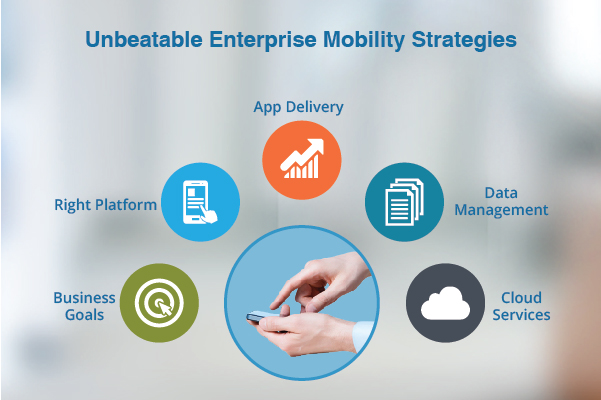Mobility is in huge demand at the enterprise level because of the growing proliferation of smart devices such as iPhone, iPad, Android, Windows and Blackberry. The evolution of higher speed mobile networks, user’s knowledge with mobile apps and mobile app stores along with a decrease in the cost of development plays an important role in the growth of enterprise mobility.
To unlock the full probabilities of enterprise mobility, enterprises need to implement BYOD policies. Continuously developing mobile trends from the Internet of Things to wearable technologies are already bringing up new points that we should consider. Every organization should develop a really comprehensive and security-conscious mobility strategy on a priority basis.
We understand this need and that is the reason here that we have mentioned the modern enterprise mobility strategies to help organizations in creating effective mobility solutions. These comprehensive strategies include design, planning of strategies, security, management, implementation, integration, deployment, and support.
Enterprise mobility is more about guidance for the business that enables the businesses to integrate and deliver quick innovative business services. It also accelerates new ways of opportunity and efficiency. Security plays an important part in making these pioneering business services possible.
An enterprise mobility strategy should be developed around three basic principles:
- Engage customers in effective ways
- Boost up employee efficiency and connectivity
- Enrich the industry with innovative services
Unbeatable Enterprise Mobility Strategies for 2016
There are many ways you can start to develop enterprise mobility strategies that will speed up your mobility revolution and make sure you are prepared for the New Year.
1. Define the business goals and outcomes
Many companies just jump into the implementation of the enterprise mobility without thinking about their business outcomes. If you want to develop successful enterprise mobility, then first think about the below questions:
- How do your employees and customers interact with each other and consume your products and services on a daily basis?
- Does your mobility strategy create new business opportunities for your organization and engage your customers?
- Are you planning to develop new mobile applications?
- Does your organization need re-engineered or upgraded and better-managed processes to deliver the right user experience for your employees and customers?
2. Choose the right platform- mobile website or native app
There are different approaches to build a mobile app; one is to create a mobile website, which is basically a website that is intended to work well on the smaller screens of a mobile device. This can be accessed at any time by using web browser of any mobile device. This technology is called responsive design.
Another is developing a native mobile application that is built for a particular device and the employer or client must download and install the app on the device before he/she uses it. Both of these approaches have their advantages and disadvantages.
In 2016 we’ll enter an era very much focused on apps for work and for getting things done, which are likely to be tied to Internet of Things (IoT), whether it has to do with helping employees become or stay healthy, or hospitals and how they triage, fix and rehabilitate people. –Bob Egan (Chief research officer, Sepharim Research)
Based on the usage, organizations need to decide which approach is suitable for them.
3. Do your best for constant application delivery
Nowadays, mobile users expect weekly or daily updates to their mobile apps. Constant application delivery for enterprise mobility needs small development cycles, regular revisions, and a capacity to support a large number of mobile platforms. This will create a level of difficulty that causes chaos with the traditional approaches to application improvement and arrangement. As a substitute, organizations need to become more active, both in terms of using successful methods in software development and move to develop methods to speed up the application delivery. Today, businesses are successful because they listen and respond to customer needs.
4. Managing information is everything. Stay focused!
Data is the heart of any enterprise mobility strategy. Industries have to recognize what happens to the data that is being used by mobile devices.
- What kind of information do people need on the devices?
- How they are going to use that data? Are they going to make changes to it?
- How does your company confirm access to data, even from the places where mobile service is insufficient? Is it okay to cache data on the mobile devices?
- Is the company able to protect the data while in transit over the network, or stored on the device that is outside of the company’s firewalls?
5. Use cloud as an ideal platform
The cloud is rising up as the ideal platform for all management systems that also include enterprise mobility management. In addition, enterprise mobility management is expanding its reach to all types of smart devices and apps including Windows 10 PCs, server, and cloud based software and cloud services. Enterprise mobility will become the operations management’s center point as more and more professionals are migrating to the cloud.
Enterprise mobility has quickly grown among industries and become a foundation element for the enterprises. If you are an organization and thinking of developing your enterprise mobility strategy, make sure you consider the range of requirements for your employees and clients. You should provide the satisfactory level of control, compliance and security for each type of data without enlisting unnecessary restrictions on the ways people choose to work. With the above given options you can deliver the comprehensive mobility strategy according to your organizational needs.









